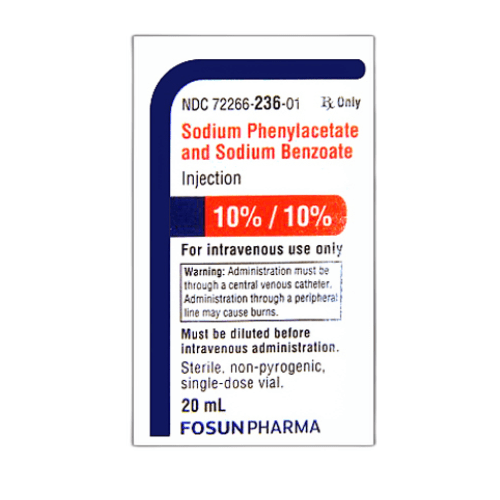
Hyperammonemia, an excessive ammonia buildup in the bloodstream, is a significant concern in metabolic disorders. It can result from factors like liver dysfunction, certain medications, or genetic defects, leading to severe complications such as neurological impairments and coma. Ammonul (Sodium Phenylacetate and Sodium Benzoate) offers a novel and promising treatment for this condition.
Generic Name: Sodium Benzoate and Sodium Phenylacetate (systemic)
Drug Class: Miscellaneous uncategorized agents
Category: Anti Hyperammonemic
About Ammonul
Ammonul (consisting of sodium benzoate and sodium phenylacetate) serves as treatment for managing acute hyperammonemia and the related encephalopathy in individuals with deficiencies in urea cycle enzymes. Ammonul functions as a nitrogen-binding agent, recommended as a supplementary therapy for addressing acute hyperammonemia and associated encephalopathy in patients experiencing enzyme deficiencies within the urea cycle.
What Is Hyperammonemia?
Ammonia, a byproduct of protein metabolism, is typically converted into urea by the liver, a process known as the urea cycle. When the liver’s ability to function is impaired or when there is a genetic defect in the urea cycle enzymes, ammonia can accumulate in the bloodstream, leading to hyperammonemia. Symptoms of hyperammonemia can vary in severity and may include:
- Nausea and vomiting
- Confusion and lethargy
- Seizures
- Coma
Mechanism of Action:
Ammonul works by interacting with ammonia to form PAG. This conversion occurs through conjugation, a process in which ammonia binds to a molecule, in this case, phenylacetate. Once converted to PAG, the body can readily excrete it through the kidneys, effectively eliminating ammonia from the bloodstream.
Clinical Efficacy:
Clinical trials have provided compelling evidence supporting Ammonul’s efficacy in managing hyperammonemia. Studies have demonstrated that Ammonul effectively reduces ammonia levels in patients with hyperammonemia, both as a monotherapy and in combination with other medications.
Precautions and Considerations for Optimal Use
Management of Immediate Hyperammonemia: Continuously monitor plasma ammonia levels throughout treatment to swiftly address the risk of brain damage or mortality. Implement necessary therapies promptly for reducing plasma ammonia levels.
Reduction in Potassium Levels: Exercise careful surveillance of plasma potassium levels, providing appropriate treatment as needed.
Concerns Related to Fluid Overload: Ammonul contains 30.5 mg of sodium per mL of undiluted product. Caution should be exercised when administering Ammonul to patients with congestive heart failure, severe renal insufficiency, or conditions involving sodium retention and edema.
Extravasation Risks: During high-flow bolus infusion, Ammonul extravasation into perivenous tissues may lead to skin necrosis, especially in infants. Close monitoring of the infusion site is crucial to identify possible tissue infiltration during drug administration.
Phenylacetate-Associated Neurotoxicity: Refrain from administering repeat loading doses due to prolonged plasma levels achieved by phenylacetate. Closely monitor patients for symptoms of acute neurotoxicity related to phenylacetate, as reported in cancer patients.
Hyperventilation and Metabolic Acidosis Concerns: Ammonul may induce side effects resembling those observed in salicylate overdose, including hyperventilation and metabolic acidosis. Regularly assess patient blood chemistry profiles and conduct frequent measurements of blood pH and pCO2.
Dosage and Administration:
Ammonul injection requires dilution with sterile 10% Dextrose Injection (D10W) prior to administration, and it should be administered exclusively through a central venous catheter. Using a peripheral line may result in burns. The administration involves an intravenous loading dose infusion lasting 90 to 120 minutes, followed by an equivalent maintenance dose infusion over 24 hours.
Drug Interactions:
- Certain antibiotics, like penicillin, can impact the overall disposition of the infused drug.
- Probenecid may influence the renal excretion of phenylacetylglutamine and hippurate.
- Valproic acid administered to individuals with urea cycle disorders may worsen their condition and counteract Ammonul’s efficacy by inhibiting the synthesis of N-acetylglutamate, a co-factor for carbamyl phosphate synthetase.
- The use of corticosteroids may lead to the breakdown of body protein, potentially elevating plasma ammonia levels in individuals with impaired urea formation capacity.
It is essential for patients to inform their healthcare providers about all medications they are taking before starting Ammonul therapy.
Addressing Special Considerations
Pregnancy: Classified as Pregnancy Category C, Ammonul lacks animal reproduction studies, leaving its impact on fetal health or reproductive capability unknown. Administration to pregnant women is advised only when deemed necessary.
Nursing Mothers: The excretion status of sodium phenylacetate, sodium benzoate, or their conjugation products in human milk is uncertain, prompting caution when administering Ammonul to breastfeeding women due to potential drug excretion in human milk.
Pediatric Use: Ammonul has proven effective in treating acute hyperammonemia in pediatric patients, including those in the early neonatal period [refer to Dosage and Administration (2)].
Geriatric Use: Clinical studies excluded patients aged 65 and over, as urea cycle disorders predominantly affect the pediatric and younger adult populations. The lack of pharmacokinetic studies in geriatric patients calls for cautious dose selection, considering potential declines in hepatic, renal, or cardiac function and concomitant diseases or drug therapy.
Gender: Comparative pharmacokinetic analysis in healthy males and females revealed slightly higher bioavailability of benzoate and phenylacetate in females. However, limited conclusions can be drawn due to the study’s small subject size.
Hepatic Insufficiency: Information on the metabolism and excretion of sodium phenylacetate and sodium benzoate in patients with impaired hepatic function is limited. Caution is urged when administering Ammonul to individuals with hepatic insufficiency, given the recognized metabolic conjugation in the liver and kidney.
Renal Impairment: Ammonul metabolites, primarily excreted by the kidney, warrant careful consideration and monitoring in patients with impaired renal function receiving Ammonul.
Availability Of Ammonul
Acquiring Ammonul online has been streamlined for your convenience. To access this medication, exclusive to the US and Europe, you can contact the SANSFRO team or other experienced firms specializing in importing medicines from these regions.
For Ammonul price, connect with our dedicated Patient Support Team at (+91) 93157 05373 or email help@sansfro.com. Our team ensures accurate and current cost details for Ammonul in the Indian market.
Conclusion:
Ammonul has emerged as a promising advance in the management of hyperammonemia, offering a novel and effective approach to reducing ammonia levels and alleviating symptoms. As research continues to explore Ammonul’s potential applications, it stands as a beacon of hope for individuals seeking relief from the challenges posed by hyperammonemia.
Reference:


